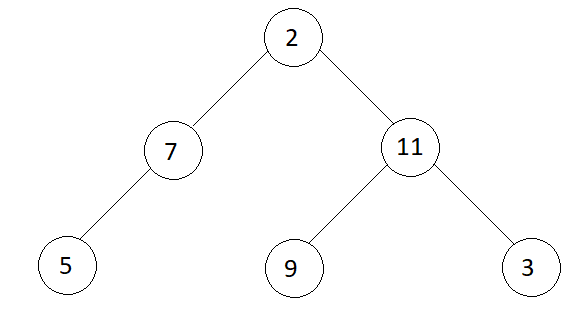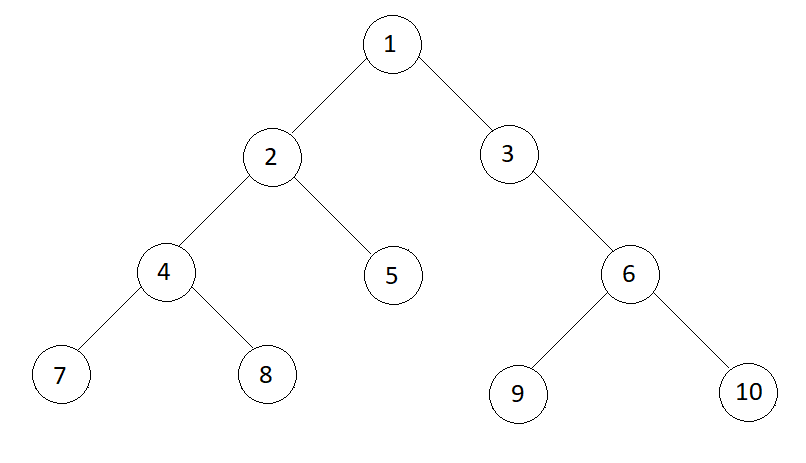Table of Contents
Problem Statement
The problem “Iterative Method to find Height of Binary Tree” states that you are given a binary tree, find the height of the tree using the iterative method.
Examples
Input

3
Input

4
Algorithm for Iterative Method to find Height of Binary Tree
The height of a tree also equals the number of levels in the tree. So to find the height using iteration, do a level order traversal of the tree and count the number of levels in it.
- Create a queue and push the root to it. Initialize height as 0.
- While the queue is not empty repeat steps 3 and 4.
- At this moment the queue contains one level of the tree. Increment height by 1. Initialize a variable size as the size of the queue.
- Run a loop from 1 to size, and at each iteration remove an element from the queue and push its children to the queue. This step will remove one level from the queue and push the next level to it.
- Return height.
Explanation
Consider the tree shown in first example,
Step 1:
Push root to queue and initialize height as 0, that is,
queue = 2, height = 0
Step 2:
Repeat step 3 and 4 while queue is not empty.
Step 3 and 4:
Iteration 1:
The queue contains the first level of tree.
Increment height, so height = 1.
Remove all the elements of queue and add their children to the queue.
queue = 7 -> 11
Iteration 2:
Queue contains the second level of the tree.
Increment height, so height = 2.
Remove all the elements of queue and add their children to the queue.
queue = 5 -> 9 -> 3
Iteration 3:
Queue contains the third level of the tree.
Increment height, so height = 3.
Remove all the elements of queue and add their children to the queue.
queue = null
As the queue becomes empty, so we stop here.
Step 5:
Return height, so the height of the tree is 3.
Code
Java code for Iterative Method to find Height of Binary Tree
import java.util.LinkedList;
import java.util.Queue;
class IterativeMethodToFindHeightOfBinaryTree {
// class representing node of a binary tree
static class Node {
int data;
Node left, right;
public Node(int data) {
this.data = data;
}
}
private static int height(Node root) {
if (root == null) {
return 0;
}
// create a queue and push root to it
Queue<Node> q = new LinkedList<>();
q.add(root);
// initialise height as 0
int height = 0;
// do a level order traversal
// while queue is not empty
while (!q.isEmpty()) {
// increment height
height++;
// initialise size as size of queue
int size = q.size();
// Remove current level from queue and push next level
for (int i = 0; i < size; i++) {
// remove an element from queue
Node curr = q.poll();
// push current element's children to the queue
if (curr.left != null)
q.add(curr.left);
if (curr.right != null)
q.add(curr.right);
}
}
// return height
return height;
}
public static void main(String[] args) {
// Example Tree 1
Node root1 = new Node(2);
root1.left = new Node(7);
root1.right = new Node(11);
root1.left.left = new Node(5);
root1.right.left = new Node(9);
root1.right.right = new Node(3);
System.out.println(height(root1));
// Example Tree 2
Node root2 = new Node(1);
root2.left = new Node(2);
root2.right = new Node(3);
root2.left.left = new Node(4);
root2.left.right = new Node(5);
root2.right.right = new Node(6);
root2.left.left.left = new Node(7);
root2.left.left.right = new Node(8);
root2.right.right.left = new Node(9);
root2.right.right.right = new Node(10);
System.out.println(height(root2));
}
}3 4
C++ Code for Iterative Method to find Height of Binary Tree
#include <bits/stdc++.h>
using namespace std;
// class representing node of a binary tree
class Node {
public:
int data;
Node *left;
Node *right;
Node(int d) {
data = d;
left = right = NULL;
}
};
// function to create a new node with data d
Node* newNode(int d) {
Node *node = new Node(d);
return node;
}
int height(Node *root) {
if (root == NULL) {
return 0;
}
// create a queue and push root to it
queue<Node*> q;
q.push(root);
// initialise height as 0
int height = 0;
// do a level order traversal
// while queue is not empty
while (!q.empty()) {
// increment height
height++;
// initialise size as size of queue
int size = q.size();
// Remove current level from queue and push next level
for (int i = 0; i < size; i++) {
// remove an element from queue
Node *curr = q.front();
// push current element's children to the queue
q.pop();
if (curr->left != NULL)
q.push(curr->left);
if (curr->right != NULL)
q.push(curr->right);
}
}
// return height
return height;
}
int main() {
// Example Tree 1
Node *root1 = newNode(2);
root1->left = newNode(7);
root1->right = newNode(11);
root1->left->left = newNode(5);
root1->right->left = newNode(9);
root1->right->right = newNode(3);
cout<<height(root1)<<endl;
// Example Tree 2
Node *root2 = newNode(1);
root2->left = newNode(2);
root2->right = newNode(3);
root2->left->left = newNode(4);
root2->left->right = newNode(5);
root2->right->right = newNode(6);
root2->left->left->left = newNode(7);
root2->left->left->right = newNode(8);
root2->right->right->left = newNode(9);
root2->right->right->right = newNode(10);
cout<<height(root2)<<endl;
return 0;
}3 4
Complexity Analysis
Time Complexity
O(n), where n is the number of nodes in the binary tree. Since we have used a queue and traversed over all the nodes in the binary tree. So it’s clear that the time complexity is linear.
Space Complexity
O(n), where n is the number of nodes in the binary tree. As already told that we have used a queue to find the height, we had stored the elements in that queue. Thus the space complexity is also linear.